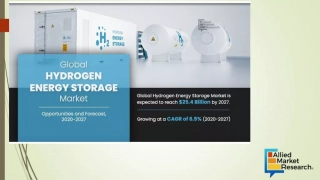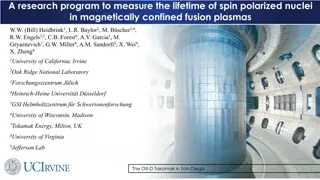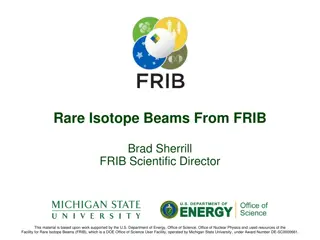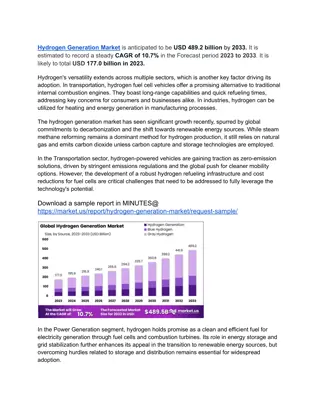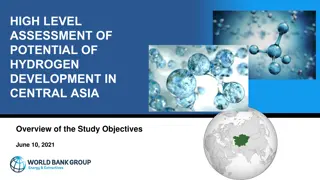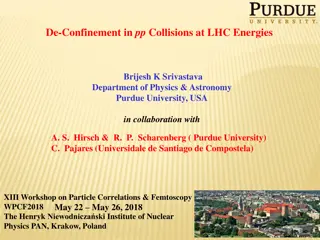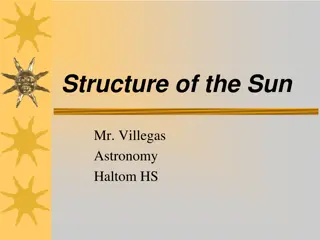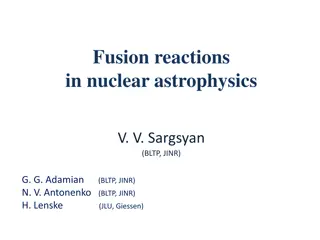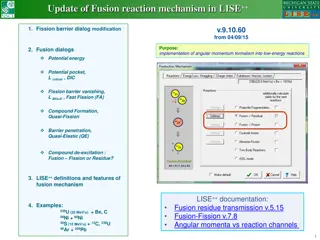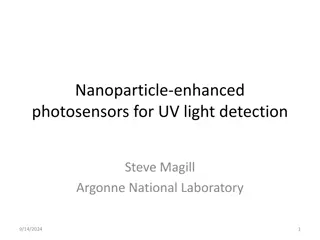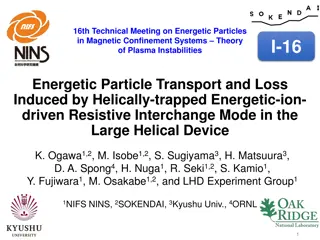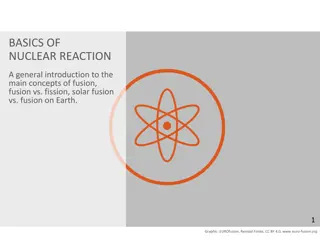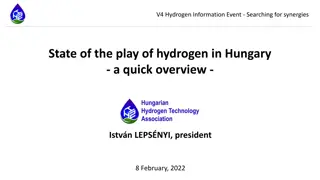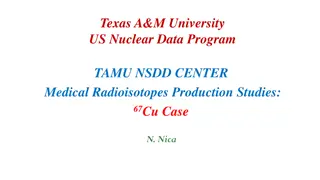Understanding Hydrogen Isotope Influence on H-Mode Confinement in Fusion Plasmas
Knowledge of how the hydrogen isotope impacts H-mode confinement is crucial for predicting energy confinement in future fusion plasmas. Research explores the relationship between isotope mass and confinement time, highlighting the optimistic outlook for future reactors. Experimental studies on hydrogen and deuterium plasmas reveal differences in heat transport and confinement characteristics, shedding light on the underlying physics. The comparison between hydrogen and deuterium behaviors provides insights into energy confinement and heat transport mechanisms in fusion plasmas.
Download Presentation

Please find below an Image/Link to download the presentation.
The content on the website is provided AS IS for your information and personal use only. It may not be sold, licensed, or shared on other websites without obtaining consent from the author. Download presentation by click this link. If you encounter any issues during the download, it is possible that the publisher has removed the file from their server.
E N D
Presentation Transcript
2/13 Introduction 1.5 Knowledge of the influence of the hydrogen isotope on H-mode confinement is essential for accurately projecting the energy confinement in future burning plasmas. deuterium 1 Wth [MJ] Energy confinement time increases with isotope mass th M with greater than 0. 0.5 hydrogen th PL-0.69 1.1MA, 2.4T 0 0 2 4 6 8 10 12 Pabs [MW] This favorable dependence of confinement on isotope mass leads to optimistic visions for a future reactor. However, the underlying physics behind the role of the hydrogen isotope has not yet clearly been understood.
3/13 Objective Pedestal Core In the present understanding, H-mode confinement is characterized by separating into pedestal and core components. Shafranov shift separatrix p(r) Pedestal stability Poloidal beta p, j 1. Investigate the dependence of the core heat transport on the isotope focusing on Tiprofiles Pedestal structure Profile stiffness WELM /a ~ p1/2 2. Examine how the hydrogen isotope is involved in the physics picture of overall H-mode confinement Heat source ELM hydrogen isotope The experiments on hydrogen and deuterium H-mode plasmas in JT-60U were used for analysis.
4/13 Experiment on hydrogen and deuterium H-mode plasmas Power scan has been attempted to examine the characteristics of hydrogen and deuterium H-mode plasmas. H: Wth= 0.7MJ, Zeff= 1.4 D: Wth= 0.9MJ, Zeff= 2.4 Pabs= 7.3 MW H D ne[1019m-3] 15 1.5 15 1.5 Ip Ip [MW] [MW] [MA] [MA] PNBI PNBI 0 2 0 4 0 2 0 4 [1019m-3] [1019m-3] ne ne [a.u.] [a.u.] D H 0 2 0 1.5 0 2 0 1.5 Te[keV] WTOT [MJ] [MJ] WTOT pTOT pTOT 10 0 0 0 0 10 11 9 7 8 6 11 9 7 8 6 time [s] time [s] 2 2 [a.u.] [a.u.] Ti[keV] 0 9.2 0 9.2 9.4 9.4 9.3 9.3 time [s] time [s] fELM= 170Hz (Psep=6.7MW) fELM= 80Hz (Psep=6.6MW) ne= 2.2 x 1019m-3 p= 0.6 (H) and 0.9 (D) Ip= 1.08 MA, BT= 2.4T q95= 3.7, = 0.35 r/a
thfor deuterium is larger by 20-30% than for hydrogen at a given power 5/13 The thdecreases continuously with Pabsfor both cases as expected from IPB98y2 scaling. However, this larger by 20-30% for deuterium than for hydrogen at a given Pabs. A pair of H and D plasmas with the same Wthare chosen for comparison. The power required to sustain the same Wthis greater for H (Pabs= 8.0MW) than for D (Pabs= 4.0MW) by a factor of two. Therefore, thof 0.1s for H becomes half that for D ( th= 0.2s).
Profiles of ne, Teand Tibecome identical while iis smaller for deuterium throughout the minor radius 6/13 Qi[10-15 Wm] ne[1019m-3] Ti[keV] r/a r/a r/a VT[102 krad/s] Te[keV] i[m2/s] r/a r/a r/a The profiles of Ti, Teand ne are obviously identical. The Qifor H is larger than for D. Therefore, the ifor H also becomes explicitly higher than for D. A larger number of perp-NBs were injected for H to keep Wththe same. This operation leads to a larger ripple loss of fast ions, which enhances the VT toward the counter direction.
Reduced ion heat diffusivity for deuterium accompanying steeper temperature gradient 7/13 The characteristics of ion heat transport are shown in a diagram of Qi/niand Ti. For both cases, the increase of Tiis less significant than that of Qi/ni, indicating that i increases gradually with the heating power. Increased power The increase of iwith the heating power is more rapid for H than for D. The angle formed between the horizontal axis and a straight line that passes through both the data and the origin of the coordinates corresponds to i(= tan ).
Ion-temperature-gradient scale length is smaller with hydrogen isotope mass 8/13 R/LTi iincreases rapidly with Ti/Tifor both H and D plasmas, indicating the profile stiffness in the variation of the heating power in this exp. 0 2 4 6 8 10 6 hydrogen deuterium r/a = 0.6 (A) 4 i[m2/s] As expected from the same Tiprofiles for (A) and (B), the ifor H is nearly two times larger than for D with the same Ti/Ti. 2 ineo linear ITG threshold (B) 0 Considering the characteristics of the rapid increase of iwith Ti/Tifor each hydrogen isotope species, this result is indicative of a smaller LTifor deuterium plasmas. 0 1 2 3 Ti /Ti[m-1]
9/13 Edge pedestal characteristics 200 fELMincreases almost linearly with Psepfor both cases; a typical feature of type-I ELMs. At a given Psep, fELMfor H becomes approximately two times larger than that for D. 165Hz hydrogen 150 fELM[Hz] 100 80Hz deuterium Over wide range of Psep, WELMis smaller by a factor of ~2 for H than that for D. 50 1.1MA, 2.4T 0 0 2 4 6 8 10 In (fELM/Psep, WELM) space, the product of both axis quantities indicates the power fraction assigned to ELM loss from the separatrix power. Psep[MW] 25 20 deuterium ELM loss power PELM(= fELM WELM) for D remains ~20% of Psepwhile it is ~10% of Psepfor H. WELM[kJ] PELM/Psep= 20% 15 PELM/Psep= 10% 10 5 The result indicates that the power assigned to the inter-ELM transport for D is smaller than that for H. hydrogen 0 0 10 20 30 fELM/Psep[Hz/MW]
10/13 Edge pedestal characteristics Despite a given Pabs, the pedestal Tivalue becomes higher for D than for H. Pabs Non-dimensional parameter scan in JT-60U has shown pedestal width pedscales as pped0.5while there is nearly no dependence on pped* [1]. This result indicates that ped is not changed directly by isotope species. However, the pedestal temperature profiles are clearly different between two cases. Discuss how this difference in the pedestal temperature appears. [1] H. Urano et al, Nucl. Fusion 48 (2008) 045008
Higher pedestal pressure is obtained in deuterium H-mode plasmas 11/13 2 Pedestal pressure evidently differs nearly by a factor of ~1.5 between H and D plasmas. The difference of ppedis mainly attributed to the difference of Tped. deuterium Teped [keV] 1 3.0kPa hydrogen 1.5kPa 1.08MA, 2.4T Pabs= 8-9MW The edge stability can be improved by the increase in pTOT[2-4]. 0 0 1 2 neped [1019m-3] The ppedis increased with increased pTOTfor both cases. Despite different types of isotope species, the relationship between pTOTand pped is almost identical. 0.4 deuterium 0.3 (A) pped 0.2 Why is larger pTOTobtained for D? Better thermal energy confinement for D is one of the contributors. Fast ion energy is also proportional to m0.5. (B) hydrogen 0.1 1.08MA, 2.4T 0 0 0.2 0.4 0.6 0.8 pTOT 1 1.2 [2] Y. Kamada et al, Plasma Phys. Control. Fusion 48 (2006) A419 [3] P. B. Snyder et al, Nucl. Fusion 47 (2007) 961 [4] A. W. Leonard et al, Phys. Plasmas 15 (2008) 056114
Schematic view of H-mode confinement involving hydrogen isotope effect 12/13 Pedestal Core Shafranov shift separatrix (i) Pedestal plays a role as a boundary condition determining the core confinement through profile stiffness p(r) (ii) Pedestal stability Poloidal beta p, j (i) (ii)Pedestal stability is improved with increased p Pedestal structure Fast ion energy isotope Profile stiffness Hydrogen WELM /a ~ p1/2 Heat source ELM fELM - Reduced heat transport for deuterium improves core confinement. - The pbecomes higher for deuterium. - Increased pimproves the edge stability and raises the pedestal pressure. - Higher pedestal in turn allows higher core confinement due to profile stiffness.
13/13 Summary The hydrogen isotope effect on H-mode confinement was examined using hydrogen and deuterium H-mode plasmas in JT-60U tokamak. (1)The thwas larger by 20-30% for deuterium than for hydrogen over a wide range of power. (2)When Wthwas fixed, the profiles of ne, Teand Tibecame nearly identical for both cases while higher heating power was required for hydrogen. The ifor hydrogen was higher than that for deuterium. (3)Ion temperature gradient scale length was smaller for deuterium compared with that for hydrogen. (4)The relationship between pTOTand ppedwas nearly the same regardless of the difference of the isotope species.


